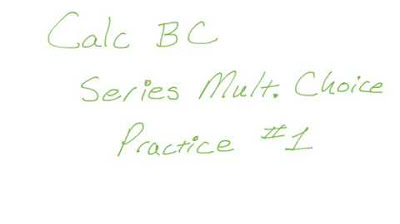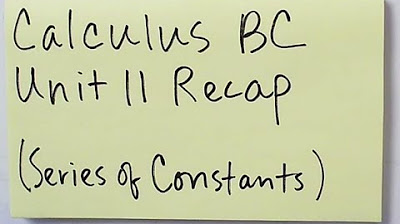Infinite Series Multiple Choice Practice for Calc BC (Part 4)
TLDRThis video script is part four of a series focusing on multiple-choice questions for the BC Calculus exam or any count two class. The presenter guides viewers through a variety of calculus series problems, discussing convergence and the application of tests such as the alternating series test, p-series test, and limit comparison test. The script highlights common pitfalls and misconceptions, such as the need to check if a series is truly alternating before applying the alternating series test. It also emphasizes the importance of recognizing dominant terms and understanding the behavior of geometric series. The presenter uses a conversational tone, making the complex topic of calculus series more accessible to students preparing for exams or looking to improve their understanding of the subject.
Takeaways
- 📚 In the video, the presenter discusses multiple-choice questions related to series convergence for calculus exams, specifically focusing on part four of a series.
- 🔍 The presenter emphasizes the importance of identifying which series converge or diverge by looking for specific patterns or applying convergence tests.
- ✅ The alternating series test is mentioned as a key method to determine the convergence of a series with alternating signs and decreasing terms.
- 🚫 The presenter points out that if the limit of the nth term of a series does not approach zero, the series will not converge, even if it alternates.
- 📉 For series that do not alternate, the presenter explains that the limit of the nth term approaching negative one or any non-zero value indicates divergence.
- 🌟 The concept of 'p-series' is introduced, where the series converges if p > 1, and the presenter clarifies which of the given options are not p-series.
- 🔢 The harmonic series is identified as a specific type of p-series with p = 1, and the presenter distinguishes it from other series that may resemble it.
- 📈 The presenter uses the limit comparison test to analyze the convergence of a series by comparing it to a known convergent or divergent series.
- 🤔 The nth term test is suggested as a preliminary check for divergence, especially for series involving trigonometric functions.
- 🧮 L'Hôpital's rule is briefly mentioned as a method to solve indeterminate forms like 0/0 that may arise when applying the nth term test or limit comparison test.
- ⛓️ Conditionally convergent series are explained as those that converge when terms are alternating but diverge when taken absolutely.
- 🎓 The presenter encourages practice and familiarity with various series tests to efficiently tackle problems on the AP Calculus exam.
Q & A
What is the main topic of the video?
-The video is focused on solving multiple-choice questions for the BC Calculus exam preparation, specifically discussing the convergence or divergence of various mathematical series.
Why does the series 2/√n converge according to the video?
-The series 2/√n converges because it is an alternating series, and by the alternating series test, it meets the criteria for convergence.
What is the issue with the series (1 - n)/n when considering its convergence?
-The series (1 - n)/n does not converge because as n approaches infinity, the limit is negative one, not zero, which violates the condition for convergence.
How does the video refute the claim that the series -(1^(n+1)) * (4√n) / (2 + √n) converges by the alternating series test?
-The video refutes this by showing that the limit as n approaches infinity of the series is 4, which is not zero, hence it does not satisfy the conditions of the alternating series test and does not converge.
What is a p-series and how does it relate to the question about which series is not a p-series?
-A p-series is a series of the form 1/n^p where p is a positive real number. In the context of the video, the series 1/n^e is identified as a p-series with p equal to e, which is greater than one, hence it converges.
Why does the video suggest that the series 4^n / 5^n - n^2 can be determined to converge or diverge using a limit comparison test?
-The video suggests using a limit comparison test because 5^n dominates n^2 as n approaches infinity, allowing the series to be simplified to a form that can be compared to a known convergent or divergent series.
What is the harmonic series and how does it relate to the question about which of the following is the harmonic series?
-The harmonic series is the series that sums the reciprocals of the natural numbers, that is, 1 + 1/2 + 1/3 + ... . The video identifies the option that represents the full harmonic series, not just a partial sum or a variation like the alternating harmonic series.
What is the condition for a series to be considered conditionally convergent?
-A series is conditionally convergent if the series of the absolute values of its terms does not converge, but the series does converge when the terms are allowed to alternate in sign.
Why does the video suggest that the series 5/k^3 converges absolutely?
-The video suggests that the series 5/k^3 converges absolutely because it is a p-series with p = 3, which is greater than 1, satisfying the condition for absolute convergence.
What is the significance of the alternating series test in determining the convergence of a series in the video?
-The alternating series test is significant as it provides a method to determine the convergence of a series with alternating signs. It is used multiple times throughout the video to assess the convergence of various series.
How does the video approach the question about the series ∑ from n=1 to ∞ of sin(1/n)?
-The video approaches this by suggesting a limit comparison test with the series 1/n. It highlights the use of L'Hôpital's rule to handle the indeterminate form that arises when taking the limit of the ratio of the series to 1/n as n approaches infinity.
Outlines
📚 Series Convergence in Calculus
This paragraph discusses the process of determining whether a series converges or diverges, focusing on question 28 of 71. The speaker identifies a series that converges by the alternating series test, which is 2 over the square root of n, and explains why the other options do not converge. The explanation involves taking the limit as n approaches infinity for each series term and checking if it equals zero, a key criterion for convergence.
🔍 Identifying True Statements in Calculus
The speaker navigates through multiple-choice questions to identify true statements about series behavior. They clarify misconceptions about the convergence of certain series using the alternating series test. The paragraph also touches on the trickiness of questions and the importance of understanding the fundamentals to avoid being misled by the question's phrasing.
🧮 P-Series and Harmonic Series Analysis
This section deals with identifying which series are not p-series and which are convergent p-series. The speaker uses the p-series test to determine divergence or convergence, noting that p must be greater than one for a p-series to converge. The harmonic series is also discussed, with the speaker pointing out that it is a specific type of p-series and is divergent.
📉 Series Comparison and Limit Tests
The speaker approaches questions about series comparison tests and limit tests. They discuss the dominance of terms within a series and how to apply comparison tests to determine if a series converges. The paragraph also includes a moment of reflection on the use of the ratio test versus the limit comparison test, highlighting a minor confusion in the approach to solving a particular problem.
🌟 Trigonometric Series and Conditional Convergence
The final paragraph covers the evaluation of trigonometric series and the concept of conditional convergence. The speaker suggests using the limit comparison test for series involving trigonometric functions and emphasizes the importance of the nth term test for divergence. They conclude with identifying a series that is conditionally convergent, which converges when alternating but not when taking the absolute value of the terms.
Mindmap
Keywords
💡Convergence
💡Divergence
💡Alternating Series Test
💡nth Term Test
💡p-Series
💡Harmonic Series
💡Geometric Series
💡Limit Comparison Test
💡Conditional Convergence
💡L'Hôpital's Rule
💡Trigonometric Series
Highlights
The video is part four of a series on multiple-choice questions for BC calculus exam preparation.
The presenter suggests looking for a series that converges by first identifying terms that alternate and decrease to zero.
The series 2/√n converges by the alternating series test due to its alternating nature and terms approaching zero.
The series 1 - n/n approaches a limit of -1, indicating divergence.
The limit of (1/2)^n as n approaches infinity is 1/2, not zero, which shows divergence.
The series (-1)^(n+1) * (cos(nπ)/n^2) does not converge by the alternating series test because it does not alternate.
The series 1/n^p, where p > 1, is a p-series that converges.
The harmonic series 1 + 1/2 + 1/3 + ... is a p-series with p = 1 and diverges.
The series 2^n/(3^n + n) can be compared to a geometric series and is found to converge.
The series 4^n/(5^n - n^2) is analyzed using the limit comparison test with the series 4^n/5^n.
The series Σ(1 to ∞) sin(1/n) is shown to diverge by limit comparison to the series 1/n.
The series (-1)^(k) * (5/k) is conditionally convergent because it diverges when taken absolutely but converges when alternating.
The video emphasizes the importance of understanding dominant terms and the p-series test for series convergence.
The presenter uses the alternating series test to quickly identify convergent series within multiple-choice questions.
The video provides a step-by-step approach to series convergence tests, including the ratio test and L'Hôpital's rule.
The series 5/k^3 converges absolutely, indicating it is not conditionally convergent.
The video concludes with a reminder of the importance of practice for mastering series convergence tests.
Transcripts
Browse More Related Video

Infinite Series Multiple Choice Practice for Calc BC (Part 2)

Infinite Series Multiple Choice Practice for Calc BC (Part 5)

Infinite Series Multiple Choice Practice for Calc BC (Part 1)

AP Calc BC Series Review Multiple Choice Practice

Calculus BC Unit 11 Recap

Infinite Series Multiple Choice Practice for Calc BC (Part 6)
5.0 / 5 (0 votes)
Thanks for rating: